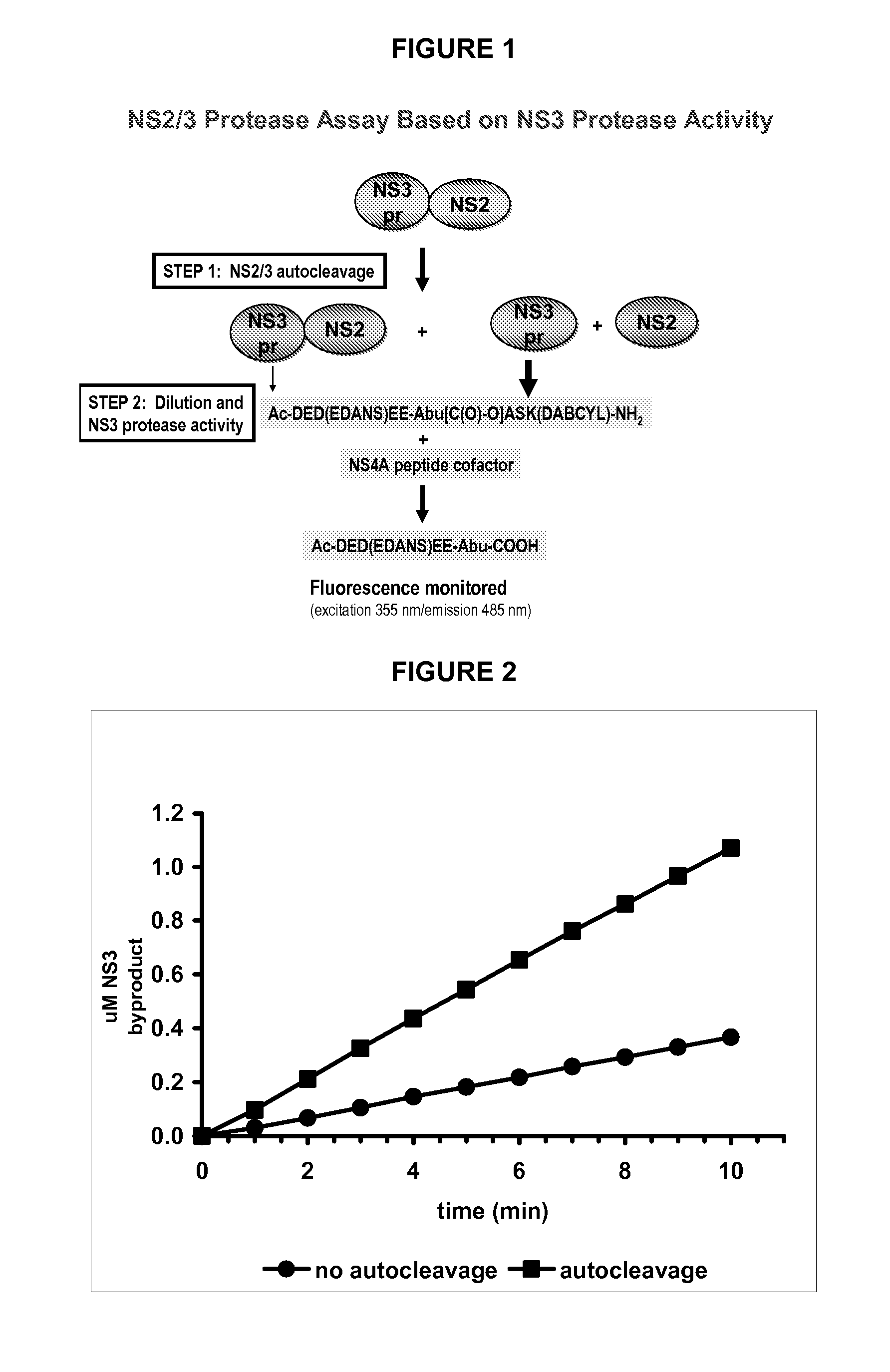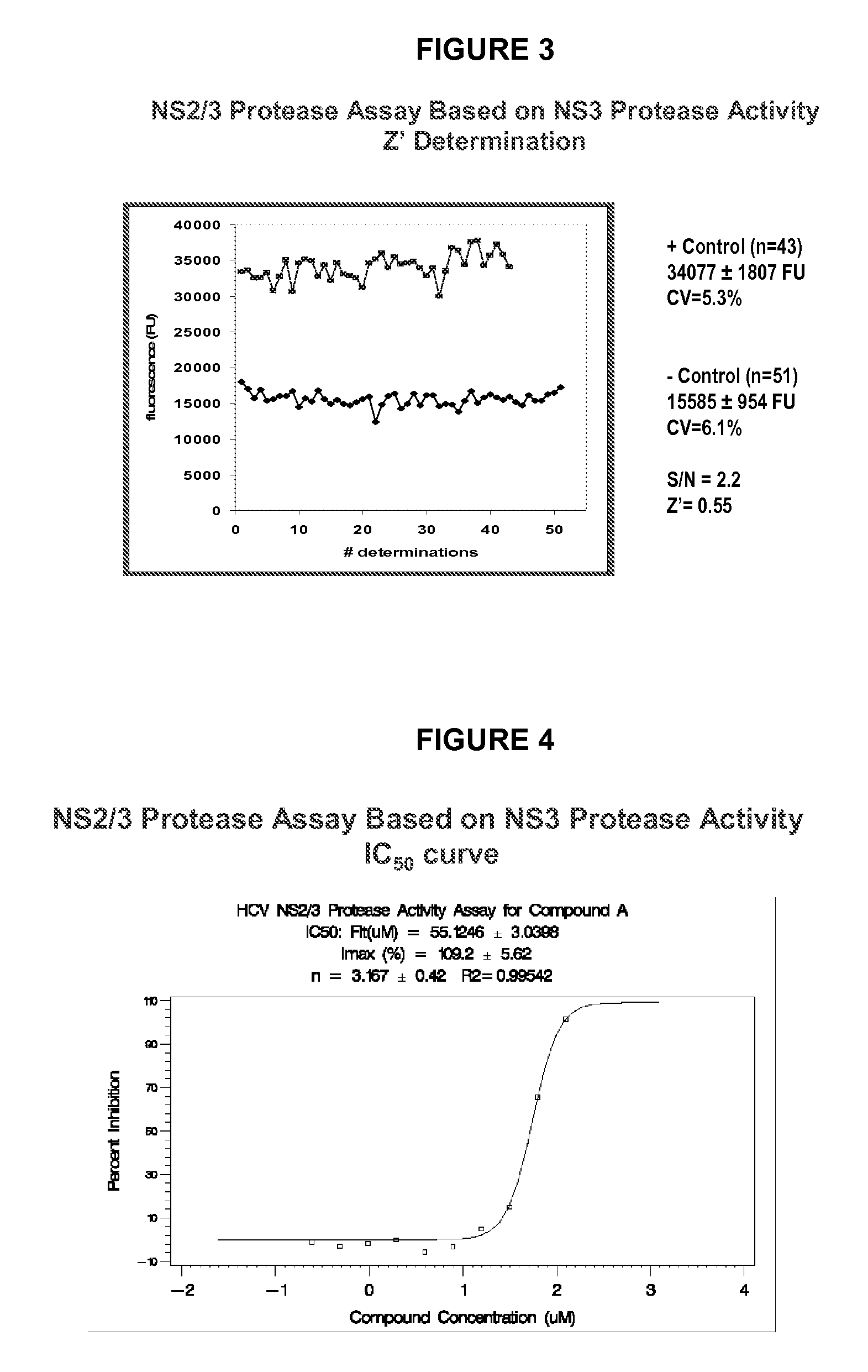Hepatitis C Virus NS2/3 Activity Assay
a cleavage activity and assay technology, applied in the field of hcv cleavage autocleavage activity assay, can solve the problems of inability to quickly detect cleavage products, time-consuming methods, and no assay has yet been developed with the selectivity to detect ns2/3 cleavage products, so as to increase the ns3 protease activity of the resulting ns3 protease product, and reduce the ns3 protease activity
- Summary
- Abstract
- Description
- Claims
- Application Information
AI Technical Summary
Benefits of technology
Problems solved by technology
Method used
Image
Examples
example 1
NS2 / 3 Protease Autocleavage
[0119] Activation of the refolded NS2 / 3 protease requires the use of detergents at concentrations above their critical micelle concentration, although some detergents do not promote autocleavage. Also, the effect of the detergent on NS2 / 3 autocleavage activity is enhanced in the presence of glycerol (2). The concentration dependence of the NS2 / 3 protease autocleavage reaction previously reported (4) is confirmed using SDS-PAGE / Western blot analysis. At concentrations greater than 200 nM, no concentration dependence is observed (data not shown). The effect of glycerol, pH and DMSO on autocleavage is also evaluated. Similar cleavage kinetics is observed in a buffer containing 20% or 30% glycerol (data not shown). Finally, autocleavage is optimal at pH 7.5 and DMSO has no effect on activity at concentrations ranging from 0.5-5% (data not shown).
[0120] Therefore, the autocleavage reaction is initiated by adding 10 μL of NS2 / 3 protease (SEQ ID NO.4) at 800 nM...
example 2
NS2 / 3 Protease Assay Based on NS3 Protease Activity
[0122] Kinetic Parameters
[0123] Kinetic parameters for the NS3 protease activity of the NS2 / 3 protease (SEQ ID NO.4) are compared to those of the NS3 protease domain and determined with the fluorogenic substrate Ac-DED(EDANS)EE-Abu[C(O)—O]ASK(DABCYL)-NH2 (SEQ ID NO.10). Substrate cleavage is continuously monitored at room temperature on a BMG POLARstar Galaxy fluorometer, equipped with excitation and emission filters of 355 nm and 485 nm, respectively, in the presence of 0.5 to 8 μM substrate. The NS3 protease activity of the NS2 / 3 protease (15 to 350 nM) and of the NS3 protease domain (1.5 to 800 nM) is assayed with and without a 1000-fold molar excess of the NS4Apeptide in 50 mM HEPES, pH 7.5, 30% glycerol, 5% DMSO, 1 mM TCEP containing 0, 0.5 or 1% LDAO. In the presence of the NS4Apeptide, a 15-min pre-incubation is introduced to allow for the formation of the protease-cofactor complex.
[0124] The catalytic efficiencies of the ...
example 3
Assay for Screening Inhibitors
[0129] This assay illustrates the kind of format that such an assay may adopt for the purposes of screening a large number of potential inhibitors of HCV NS2 / 3 protease. As will be apparent from this description, appropriate controls must be run in parallel to evaluate background NS3 protease activity of the uncleaved NS2 / 3 protein in order to subtract such background activity.
[0130] Assay Description
[0131] The NS2 / 3 protease Lys4-His6-[NS2 / 3 (904-1206)]-streptag-Lys4 [SEQ ID NO.4] is the one used in that assay [enzyme production, purification and refolding are described in (2)]. The autocleavage reaction is performed in a buffer containing n-dodecyl-β-D-maltoside (DM) and glycerol (±test compound) and is initiated by adding the NS2 / 3 protease followed by a 45-min incubation at room temperature. Assessment of autocleavage is based on monitoring the protease activity of the NS3 protease product. Conditions are found in which the NS3 protease activity ...
PUM
| Property | Measurement | Unit |
|---|---|---|
| pH | aaaaa | aaaaa |
| time | aaaaa | aaaaa |
| pH | aaaaa | aaaaa |
Abstract
Description
Claims
Application Information
 Login to View More
Login to View More - R&D
- Intellectual Property
- Life Sciences
- Materials
- Tech Scout
- Unparalleled Data Quality
- Higher Quality Content
- 60% Fewer Hallucinations
Browse by: Latest US Patents, China's latest patents, Technical Efficacy Thesaurus, Application Domain, Technology Topic, Popular Technical Reports.
© 2025 PatSnap. All rights reserved.Legal|Privacy policy|Modern Slavery Act Transparency Statement|Sitemap|About US| Contact US: help@patsnap.com



